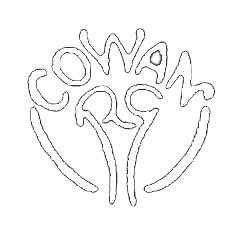Cowan Pottery Museum Exhibition
 New Exhibit!
New Exhibit!
Fruit of Jewels
Semi-Permanent Exhibit
Come see this exhibition of luster, iridescent, and crystalline glazes from the Cowan Pottery. R. Guy Cowan experimented with glazes since he first came to Cleveland in 1908 as an instructor for East Technical High School. In 1911 a Plain Dealer article announced Cowan’s major breakthrough as the first artist to develop an iridescent glaze for ceramics. The Cowan Pottery Studio became known for its innovative use of glazes and would later highlight metallic luster in many of its designs. Iridescent glazes remained popular throughout the years and were used by the Studio until 1927.
 100 Years of Cowan Pottery
100 Years of Cowan Pottery
The materials in these two exhibitions give us a look back in time to when the Cowan Pottery Studio was in operation in Rocky River. In The Studio on Lake, we have a collection of staged photos produced some time in the late 1920s. They allow us to see what the studio looked like during its operation and offer a glimpse of the ceramic process. Cowan Style is a collection of photographs used in the dealer’s catalogs Cowan produced from 1925-1931. We not only see how the works were advertised but also the objects staged in use. Many of these photos were most likely taken in the studio’s original showroom.
Hist ory
ory
Guy Cowan first came to Northeast Ohio in 1909 to work as an instructor for East Technical High School. While teaching, Cowan continued his own ceramic practice which eventually led to him leaving his position at the school and opening his own studio on Nicholson Ave in Lakewood, The Cleveland Pottery & Tile Company. Established in 1913 with the assistance of financial backing from admirers of Cowan’s work, the studio produced housewares as well as tile commissions for public buildings and private residences. The company continued its successful operation until 1917 when Cowan entered the Army and served as a Captain in the Chemical Warfare Service. Upon his return in 1919 Cowan discovered he had to relocate his business due to the site’s natural gas wells drying up in his absence.
Over the course of a year, Cowan established his new studio on Lake Ave and was able to re-open as the Cowan Pottery Studio in 1920. The new studio had nine kilns and a small house on the property which was converted into the studio’s showroom. During the ’20s the studio prospered and a nationwide dealer network with some 1200 outlets was formed. The studio’s work was in such stores as Marshall Field of Chicago, Wanamaker’s of Philadelphia, Kauffman of Pittsburgh, Ovington of New York, and Halle’s of Cleveland. At the studio’s height, it had 35 employees and was producing around 175,000 ceramic pieces a year. This success lead to the expansion of the studio including new kilns and a showroom. This all changed in 1929 with the Wall Street Crash. Faced with difficult economic times, Cowan tried to save the business with a renewed focus on commercial tile production. For example, he created new designs for tiled soda fountains that were installed across the Great Lakes. Unfortunately, this wasn’t enough to save the business. The studio declared bankruptcy in 1930 and closed in 1931.
New! Cowan Pottery Museum Online Collection
Cowan Pottery Museum | What’s New? | Programs & Events | Cowan Activities @ Home

